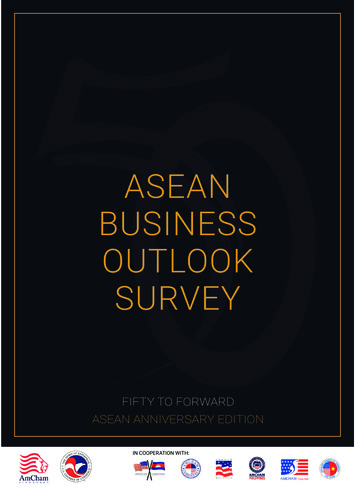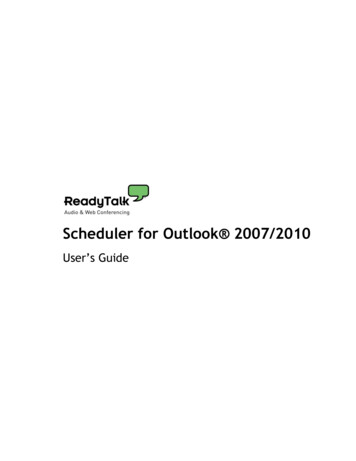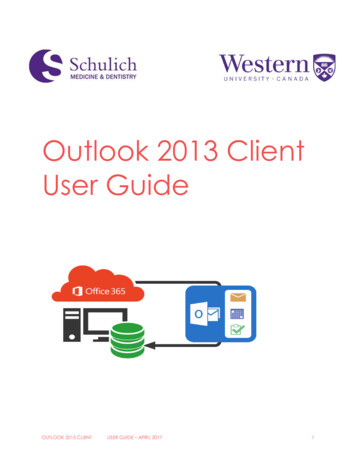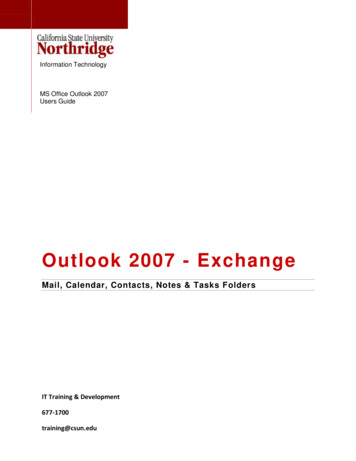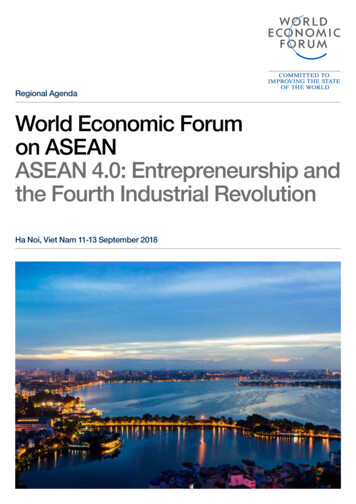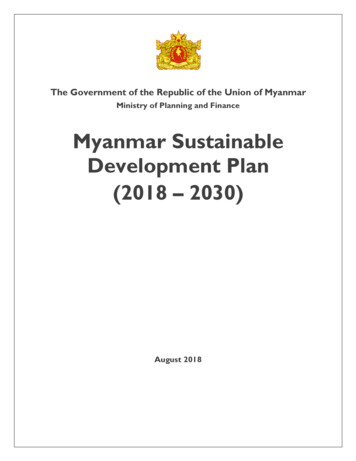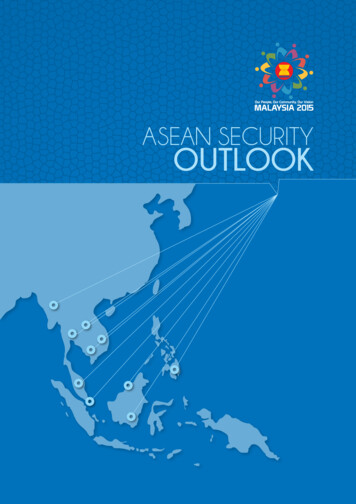
Transcription
1asean securityoutlookasean security outlook 2015
2asean security outlook 2015
3table of contentsChapter I–PrefaceFOREWORD 7introduction and executive summary 8CHAPTER II - ASEAN PRINCIPLES, VISION ANDGOALS ON REGIONAL PEACE, SECURITY ANDSTABILITY 11CHAPTER III - SECURITY CONCERNS IN THE REGIONAND NATIONAL DEFENCE AND SECURITY POLICIESBRUNEI DARUSSALAM 21CAMBODIA 2733LAO PDR 45MALAYSIA 49MYANMAR 55PHILIPINE 59SINGAPORE 65THAILAND 71VIETNAM 79INDONESIACHAPTER IV - FUTURE TRENDS A REGIONALSETTING 83asean security outlook 2015
4asean security outlook 2015
5chapter IPrefaceasean security outlook 2015
6asean security outlook 2015
7forewordDATO’ SRI ANIFAH AMANMinister of Foreign AffairsMalaysiaOn behalf of the Association of Southeast Asian Nations, I am pleased to present the Second Editionof the ASEAN Security Outlook.Inaugurated in 2013, the publication of this report is intended to complement the current annuallyreleased ASEAN Regional Forum Security Outlook. This is done with a view to promoting greatertransparency, confidence and understanding of regional defence policies and security perceptions.The contributions by ASEAN Member States to this report reflects their determination to developconstructive dialogue and consultation on political and security issues of common interest andconcerns in this region. Such an exchange of views is essential in strengthening mutual understandingand trust among countries in the region and beyond.This report offers many useful experience and lessons for ASEAN Member States to strengthentheir capacities and confidence-building measures in addressing the emerging traditional and nontraditional security challenges. Drawing from these experience and lessons, I am confident thatASEAN Member States could benefit greatly from the various security initiatives and approacheshighlighted in this report. This would eventually lead to more constructive efforts towards promotingpeace, security and stability in this region.Towards this end, allow me to express my deep gratitude and appreciation to all ASEAN MemberStates for their contributions to this publication.asean security outlook 2015
8asean security outlook 2015
9introduction andexecutive summaryT h e AS E AN S e c u r i t yO u t l o o k 2 0 1 5 ( AS O 2 0 1 5 )represents continuingefforts by ASEAN MemberStates towards promotinggreater transparency andunderstanding of each other’sdefence policy as well asperspectives on the regionalsecurity environment since thepublication of the inauguralASO in 2013. This compilationhighlights each ASEAN MemberState’s immediate securityconcerns, its national defenceand security policies, and itscontributions to promotepeace, security and stabilityin the region. It also outlinesAS E AN ’ s c o l l e c t i v e a n dcooperative efforts in achievingits goals and objectives in thepolitical and security fields.T h e AS O 2 0 1 5 m a k e sreference to seminal historicalinstruments, such as the 1971Zone of Peace, Freedom andNeutrali ty ( ZO PFAN), t he1976 Treaty of Amity andCooperation in Southeast Asia(TAC), the 1995 Southeast AsianNuclear Weapon-Free ZoneTreaty (SEANWFZ), the 2002Declaration on the Conductof Parties in the South ChinaSea (DOC) and the 2008 ASEANCharter, which underscoreASEAN’s commitment to createa peaceful and prosperouscommunity of nations. Since2009, this commitment hasbeen guided by the ASEANPolitical-Security Community( A P SC ) B l u e p r i n t w h i c hprovides a roadmap andtimetable to establish theAPSC by 2015.In terms of security concernsin the region, the MemberStates acknowledge thatASEAN’s collective effortshave contributed to a stable,peaceful and secure SouthEast Asia region althoughtraditional and non-traditionalsecurity challenges continue topose significant risks and maythreaten the region’s economicgrowth and prosperity.Similarly, ASEAN should bemindful of the interactionsbetween major powers in theregion which, if not carefullymanaged, could undermineASEAN’s achievements andaccomplishments over theyears.ASEAN’s various securityrelated mechanisms toaddress these securitychallenges such as the ASEANRegional Forum (ARF), theASEAN Ministerial Meeting onTransnational Crime (AMMTC),the ASEAN Defence Ministers’Meeting (ADMM) and the newlyestablished ASEAN MinisterialMeeting on Drugs (AMMD)have been beneficial. Engagingexternal partners in someof these mechanisms haveenabled ASEAN to collaboratefor mutual benefit whilebuilding trust and confidenceamong the countries involved.The establishment of theASEAN Community by theend of the year would enableASEAN to become a morerobust grouping and wouldensure ASEAN’s leadershiprole in the evolving regionalarchitecture. In this context,ASEAN continues to emphasisethe importance of upholding theprinciple of ASEAN centralityand ASEAN unity particularly inits engagement with externalpartners through the existingASEAN-led mechanisms. Withthe realisation of the ASEANCommunity by the end of 2015,ASEAN is set to play a moreactive and constructive role inglobal affairs and at the sametime maintain its centrality.It is my sincere hope thatthis publication would providevaluable insights into ASEAN’spolicies and perspectives ondefence and security not onlyfor the present but also forthe future. It would also bean important reference for allthose who are keenly watchingdevelopments in the region.H.E Le Luong MinhSecretary- GeneralASEAN Secretariatasean security outlook 2015
10asean security outlook 2015
11chapter IIASEANPrinciples, Visionand Goals onRegional Peace,Security andStabilityasean security outlook 2015
12 ASEAN Principles, Vision and Goals on RegionalPeace, Security and StabilityIntroductionThe publication of the ASEAN Security Outlook aims to promote greater transparency andunderstanding of each ASEAN Member States’ defence policy and security situation in the region.This is the second publication of the ASEAN Security Outlook, and is part of the implementation ofone of the action lines of the ASEAN Political-Security Community (APSC) Blueprint which calls forthe development of an ASEAN Security Outlook.This chapter lays the foundation of the ASEANSecurity Outlook by providing an overview ofASEAN’s contribution to regional peace, securityand stability based on the commitment containedin various ASEAN documents and mechanisms.The first section of this chapter focuses on themilestone political documents of ASEAN, whilethe second part looks at the security cooperationin ASEAN.CHAPTER II. A - ASEAN PRINCIPLES, VISIONAND GOALS ON REGIONAL PEACE, SECURITYAND STABILITY BASED ON EXISTING ASEANDOCUMENTSDesiring to establish a firm foundation forcommon action to promote regional cooperationin Southeast Asia in the spirit of equality andpartnership, and thereby contribute towardspeace, progress and prosperity in the region,five countries signed the ASEAN Declaration(Bangkok Declaration) on 8 August 1967. Thisled to the establishment of the Association ofSoutheast Asian Nations (ASEAN), built based onmutual respect and understanding to promotecloser cooperation among its Member States.Since its establishment in 1967, ASEAN hasplaced the promotion of regional peace andsecurity at the forefront of its endeavours.asean security outlook 2015The Bangkok Declaration defines the goals aswell as the activities of the organisation intothree objectives: To promote the economic, social and culturaldevelopment of the region through cooperativeprograms. To safeguard the political and economicstability of the region against big powerrivalry. To serve as a forum for the resolution ofintra-regional differences.Zone of Peace, Freedom and Neutrality (ZOPFAN)Political and security cooperation is indeed vitalfor ASEAN Member States. In 1971, the Zone ofPeace, Freedom and Neutrality (ZOPFAN) wassigned, with the aim of ensuring the region’sfreedom from any form or manner of interferenceby outside powers. ZOPFAN is also aimed atbroadening the areas of cooperation that wouldcontribute to the strength, solidarity and closerrelations among the Member States. The ZOPFANwas the first document that set ASEAN’s visiontowards security cooperation in the region.Nine years after the establishment of ASEAN,the Leaders of ASEAN Member States heldtheir first Summit on 24 February 1976, in Bali,Indonesia. They signed three major documentswhich have gradually shaped the political securitylandscape of the region. These were the Treatyof Amity and Cooperation in Southeast Asia(TAC), the Declaration of ASEAN Concord andthe Agreement on the Establishment of theASEAN Secretariat.
Treaty of Amity and Cooperation in SoutheastAsia (TAC)more effectively the growing interest of nonASEAN Member States to accede to the TAC.ASEAN’s norms and values continue to receiveinternational recognition through the keyinstruments initiated by ASEAN Member States,namely the 1976 Treaty of Amity and Cooperationin Southeast Asia (TAC). In the area of shapingand sharing of norms, the Treaty of Amity ofCooperation in Southeast Asia (TAC) continuesto be the main political instrument governingthe conduct of inter-State relations in SoutheastAsia.To date, there are 32 High Contracting Partiesto the TAC. Among the 22 non-ASEAN MemberStates are the five permanent members ofthe UNSC, Brazil (the first country to accedeto the TAC) and the European Union (the onlyHigh Contracting Party which is a regionalorganisation). The latest signatory to the TACis Norway on 30 June 2013.The TAC embodies universal principles ofpeaceful coexistence and friendly cooperationamong States in Southeast Asia. The TACstipulates, in their relations with one another,that the High Contracting Parties shall be guidedby the following fundamental principles: Mutual respect for the independence,sovereignty, equality, territorial integrityand national identity of all nations. The right of every State to lead its nationalexistence free from external interference,subversion or coercion. Non-interference in the internal affairs ofone another. Settlement of differences or disputes bypeaceful means. Renunciation of the threat or use of force. Effective cooperation among themselves.In 1987, the TAC was amended to allow countriesoutside of Southeast Asia to accede to theTreaty. The Treaty was amended once again in1998 to identify by name which High ContractingParties are States in Southeast Asia with theright to give consent to accession by statesoutside Southeast Asia. In order to streamlinethe process of accession to the Treaty, theGuidelines for Accession to the TAC was adoptedby the ASEAN Foreign Ministers on 7 April 2010in Ha Noi.The revised Guidelines for Accession to theTAC was adopted by the 47th ASEAN ForeignMinisters Meeting (AMM) on 30 June 2013 inBandar Seri Begawan to help ASEAN manageChapter IV of the TAC, entitled “Pacific Settlementof Disputes” provides a mechanism to settledisputes through regional processes, wherebythe High Council, comprising of a Representativeat the ministerial level from each of the HighContracting Parties, take cognizance of theexistence of the disputes or situations likely todisturb regional peace and harmony. The HighCouncil can also recommend appropriate meansof settlement such as good offices, mediation,inquiry or conciliation.Treaty on the Southeast Asia Nuclear WeaponFree Zone (SEANWFZ)2015 marks the twentieth anniversary of theTreaty of Southeast Asia Nuclear Weapon-FreeZone (SEANWFZ Treaty), which was signedby ASEAN Leaders on 15 December 1995 inBangkok, Thailand. The Treaty, which commitsthe region to nuclear disarmament and nonproliferation, entered into force on 27 March1997. This commitment was further reaffirmedin the ASEAN Charter which, among others,seeks to preserve Southeast Asia as a NuclearWeapon-Free Zone and free of all other weaponsof mass destruction.A Southeast Asia free of nuclear weapons is anessential component of the ZOPFAN and wouldcontribute towards strengthening the securityof States within the region and enhancinginternational peace and security as a whole.The Treaty includes a Protocol designed for thefive Nuclear Weapon States (NWS) to accede toin order to recognise and support SEANWFZ.asean security outlook 201513
14Under the Treaty, States Parties are obliged,among others, to the following: Not to develop, manufacture, acquire, possessor have control over nuclear weapons; stationnuclear weapons; or test or use nuclearweapons anywhere inside or outside thetreaty zone. Not to take any action to assist or encouragethe manufacture or acquisition of any nuclearexplosive device by any state. Not to provide source or special fissionablematerials or equipment to any Non-NuclearWeapon State (NNWS), or any Nuclear WeaponState (NWS) unless subject to safeguardsagreements with the International AtomicEnergy Agency (IAEA). To prevent in the territory of States Partiesthe stationing of any nuclear explosive device. To prevent the testing of any nuclear explosivedevice. Not to dump radioactive wastes and otherradioactive matters at sea anywhere withinthe zone, and to prevent the dumping ofradioactive wastes and other radioactivematters by anyone in the territorial sea ofthe States Parties.The SEANWFZ Treaty has become one of thecornerstones in the APSC. The Treaty reinforcesthe foundation for all ten States Parties tocooperate on keeping Southeast Asia freeof nuclear weapons. Such commitment hascontributed to the global non-proliferationregime towards complete disarmament ofnuclear weapons.In order to ensure that the States Parties areable to fully realise the goals and objectives setforth in the Treaty, the SEANWFZ Commission,at its Meeting on 29 July 2007 in Manila, thePhilippines, adopted the Plan of Action (PoA)to Strengthen the Implementation of theSEANWFZ Treaty. The PoA identifies measuresand actions that States Parties shall endeavourto undertake in five years (2007-2012). The newPlan of Action to Strengthen the Implementationof the SEANWFZ Treaty (PoA) for 2013-2017 wasadopted during the 46th AMM in June 2013 witha renewed commitment and a stronger emphasison concrete actions.asean security outlook 2015These actions and measures are classified intofour main headings. They are summarized asfollows:(i) Compliance with the undertakings in theSEANWFZ Treaty;(ii) Accession by Nuclear Weapon States(NWSs);(iii) Cooperation with the IAEA and otherpartners; and(iv) Institutional Arrangements.Declaration on the Conduct of Parties in theSouth China Sea (DOC)On the issue of the South China Sea, ASEAN hasbeen working actively to maintain peace andstability in the area. The ASEAN Declarationon the South China Sea was signed by ASEANForeign Ministers in Manila, Philippines, on22 July 1992. This Declaration reaffirmed thepeaceful and constructive approaches to theSouth China Sea issues.On 4 November 2002, ASEAN and the People’sRepublic of China signed the Declaration onthe Conduct of Parties in the South China Sea(DOC), which shows the commitment of theparties to the peaceful settlement of disputesin accordance with international law, includingthe 1982 United Nations Convention on the Lawof the Sea (UNCLOS) and TAC. This declarationpromotes self-restraint among parties in theconduct of activities that would complicate orescalate disputes and affect peace and stabilityin the region. DOC is also intended to intensifyefforts to seek ways, in the spirit of cooperationand understanding, to build trust and confidencetowards the eventual conclusion of a code ofconduct.On 21 July 2011, the Guidelines for theimplementation of the DOC were formallyendorsed by the ASEAN-China MinisterialMeeting in Bali, Indonesia. This was a significantoutcome and a major step forward in theimplementation of the DOC.
In July 2012, as a result of consultations amongthe ASEAN Foreign Ministers, the “ASEAN’s SixPoint Principles on the South China Sea” wasissued. The ASEAN Foreign Ministers resolve tointensify ASEAN consultation in the advancementof the Six-Point Principles, consistent with theTreaty of Amity and Cooperation in the SoutheastAsia (1976) and the ASEAN Charter (2008).The ASEAN CharterFor over four decades ASEAN worked without aformal legal guideline. ASEAN Member Statesrealised that an instrument was needed to laythe foundation of the institution and provideASEAN with a legal status.The ASEAN Charter serves as a firm foundationin achieving the ASEAN Community by providinglegal status and institutional framework forASEAN. It also codifies ASEAN norms, rulesand values, sets clear targets for ASEAN andpresents accountability and compliance.The ASEAN Charter was signed at the Summitin Singapore on 20 November 2007 as ASEANcelebrated its 40th anniversary of its foundingin 1967. With the entry into force of the ASEANCharter on 15 December 2008, ASEAN henceforthbegan operating under a legal framework andestablished a number of new organs to boostits community building process. The Charterentered into force on 15 December 2008.In effect, the ASEAN Charter is a legally bindingagreement among the 10 ASEAN Member States.Since the Charter, new organs have been setup to support the community-building process.Several legal and administrative instruments,ranging from agreements and protocols to termsof reference, rules of procedure and operationalguidelines, have been adopted or are beingdeveloped to apply specific provisions of theASEAN Charter.In the preamble of the ASEAN Charter, it isstated that ASEAN is committed to intensifyingthe community building through enhancedregional cooperation and integration, inparticular by establishing an ASEAN Community;which includes the ASEAN Political-SecurityCommunity (APSC). The initiative of establishingan APSC was deliberated in 2003. In the sameyear, ASEAN adopted the Bali Declarationof ASEAN Concord II, which recognised thatsustainable economic development requires asecure political environment based on a strongfoundation of mutual interests generated byeconomic cooperation and political solidarity.During the 12th ASEAN Summit in Cebu,Philippines on 13 January 2007, the Leadersacknowledged the need to respond to theincreasing number of regional challenges withdeeper political and security cooperation. TheAPSC is aimed to ensure that the people andMember States of ASEAN live in peace withone another and with the world at large in ajust, democratic and harmonious environment.During the 14th ASEAN Summit in Thailandin 2009, ASEAN Leaders adopted the APSCBlueprint which provides a roadmap consisting143 action lines and timetable to establish thecommunity by 2015.The APSC Blueprint itself is designed to promotepeace and security in the region by elevatingASEAN’s political and security cooperation to ahigher plane. It has three key characteristics,which are a rules-based Community of sharedvalues and norms; a cohesive, peaceful, stableand resilient region with shared responsibilityfor comprehensive security; and a dynamicand outward-looking region in an increasinglyintegrated and interdependent world.11. the full implementation of the Declaration on the Conduct of Parties in the South China Sea (2002); 2. the Guidelines for the Implementation of theDeclaration on the Conduct of Parties in the South China Sea (2011); 3. the early conclusion of a Regional Code of Conduct in the South China Sea;4. the full respect of the universally recognized principles of International Law, including the 1982 United Nations Convention on the Law of the Sea(UNCLOS); 5. The continued exercise of self-restraint and non-use of force by all parties; and 6. the peaceful resolution of disputes, in accordancewith universally recognized principles of International Law, including the 1982 United Nations Convention on the Law of the Sea (UNCLOS).asean security outlook 201515
16CHAPTER II. B - ASEAN CONTRIBUTION TOREGIONAL PEACE, SECURITY, AND STABILITYSince its establishment in 1967, ASEAN hasplaced the promotion of regional peace andsecurity at the forefront of its endeavours. Thefollowing section will highlight the current stateof cooperation among ASEAN Member Statesand between ASEAN and Dialogue Partners inaddressing both traditional and non-traditionalsecurity threats and challenges in the AsiaPacific region.Towards a comprehensive regional securityarchitectureASEAN has taken a proactive approach in evolvinga comprehensive regional security architectureby building ASEAN-centric regional securityframeworks. One such framework is the ASEANRegional Forum (ARF). It was established in1994 as a venue to foster constructive dialogueand consultation on political and security issuesof common interest and concern. The ARF hasalso contributed to towards confidence-buildingand preventive diplomacy in the Asia-Pacificregion. The ARF, now comprising 27 participatingcountries, convened its 22nd Ministerial Meetingin Kuala Lumpur on 6 August 2015.The ARF adopted a three stage evolutionaryapproach in addressing security challenges inthe region, namely:(i) Stage I: Promotion of confidence-buildingmeasures;(ii) Stage II: Development of preventivediplomacy mechanisms; and(iii) Stage III: Development of conflict-resolutionmechanisms.Confidence-building measures have takenshape in the form of regular discussions amonggovernment officials and Foreign Ministers of theARF participants. Their regular interactions havehelped facilitate candid and frank discussions,thereby encouraging greater transparency,mutual trust and understanding.asean security outlook 2015ARF Ministers adopted the “Hanoi Plan of Actionto Implement the ARF Vision Statement” in July2010 as policy guidance to develop and implementconcrete and practical actions, especially in thecontext of moving the ARF process forward in itsevolution. Six areas of cooperation are identifiedin the Plan of Action as the basis for the ARF’sfuture work, namely disaster relief, counterterrorism and transnational crime, maritimesecurity, non-proliferation and disarmament,peacekeeping operations and defence dialogues.To guide cooperation on these priority areas,the Work Plans on Disaster Relief, CounterTerrorism and Transnational Crime, MaritimeSecurity, and Non-Proliferation and Disarmamenthave been developed.In addition, the adoption of the ARF Work Planon Preventive Diplomacy in July 2011 markeda significant juncture in the evolution of theARF from stage I to stage II. The Work Planoutlines the definition, objectives, principles,and implementation of preventive diplomacythrough mechanisms such as capacity building,establishment of offices and fact-finding andobserver missions, possible expansion of thefunctions of the ARF Experts and EminentPersons (EEPs), other mechanisms identifiedin the TAC and, in the long term, more directmethods such as mediation/facilitated dialogueor conciliation.In moving forward the ARF process into a moreaction-oriented one, the ARF has conductedseveral exercises in the area of disaster relief.The first exercise conducted by the ARF was theVoluntary Demonstration of Response (VDR) heldin the Philippines in May 2009, which was followedby the ARF Disaster Relief Exercise (ARF DiREx)held in Indonesia in March 2011. Emulating thesuccesses of the two exercises, the ARF DiREx2013 was conducted in Thailand on 7-11 May 2013.The exercise aimed at testing ASEAN and ARFdisaster response mechanisms, exploring howto build effective linkages and interface amongthese mechanisms and strengthening civilmilitary coordination among ARF participatingcountries.
The ARF DiREx 2015 was successfully conductedin Kedah, Malaysia from 24 to 28 May 2015. Theexercise, which was co-hosted by Malaysiaand China, included Field Training Exercisesincluding Collapsed Structure, Mass Evacuation,Chemical Leakage (HAZMAT), Road TrafficAccident, After Action Review and Search &Rescue Operations. The marine component of theexercise included Search and Rescue operationsusing a simulated maritime incident, and alsohelicopter operations to locate survivors aswell as diving operations to evacuate trappedpersonnel.Addressing non-traditional security issuesASEAN Member States have developed andadopted instruments to address transnationalcrime in the region, namely the ASEANDeclaration on Transnational Crime, the ASEANPlan of Action to Combat Transnational Crime,and the Work Programme to Implement theASEAN Plan of Action to Combat TransnationalCrime. The ASEAN Ministerial Meeting onTransnational Crime (AMMTC) was establishedas the highest Sectoral Body in ASEAN todiscuss issues related to transnational crime.The AMMTC is convened every two years whilethe Senior Officials’ Meeting on TransnationalCrime (SOMTC) convenes annually. At the 10thAMMTC in Kuala Lumpur on 28 September – 1October 2015, the Meeting agreed to convene theAMMTC annually beginning in 2017. The AMMTCand SOMTC discuss cooperation in eight priorityareas, namely terrorism, illicit drug trafficking,trafficking in persons, arms smuggling, seapiracy, money laundering, international economiccrime and cybercrime. In addition to thesepriority areas, the AMMTC/SOMTC have agreedto include the area of Illicit Trafficking of Wildlifeand Timber under its purview. As there is astrong connection between people smugglingand trafficking in persons, the AMMTC/SOMTChave also agreed to take on the transnationalcrime aspect of the issue of people smuggling.The ASEAN Convention on Trafficking in Personsespecially Women and Children (ACTIP) andits corresponding action-oriented document,the ASEAN Plan of Action especially Womenand Children (APA) was endorsed by the 10thASEAN Ministerial Meeting on TransnationalCrime (AMMTC).The convention was developed with a view toachieving a regionally agreeable framework oncollaboration among ASEAN Member States oninvestigation and prosecution of trafficking inpersons’ cases as well as on providing assistanceto the victims for their safe return, rehabilitationand reintegration into their respective societies,among others.The Convention and its Plan of Action will adoptedby the Leaders at the 27th ASEAN Summit inNovember 2015.To date, ASEAN has issued joint declarationswith all its Dialogue Partners, individually,on cooperation to combat terrorism. With anumber of its Dialogue Partners, ASEAN is alsoimplementing Plans of Action on these jointdeclarations on combating terrorism.The SOMTC also hold consultations with mostof ASEAN’s Dialogue Partners on issues ofregional concern in response to the threats oftransnational crime. The consultations withAustralia, China, the EU, Japan, New Zealand,Republic of Korea, Russia and the United Stateshave been held to develop future practicalcooperation in supporting ASEAN’s efforts tostem transnational crime in the region.Fighting the scourge of illegal drugs andnarcoticsAs early as 1972, ASEAN has recognised theincreasing regional threat of drugs and theimportance of cooperation to fight againstthe menace. ASEAN cooperation in drugs andnarcotics control was institutionalised underthe purview of the Meeting of the ASEAN DrugExperts held in 1976. Four major areas wereidentified, namely enforcement and legislation;treatment and rehabilitation; prevention andinformation; and training and research. TheASEAN Senior Officials Meeting on Drug Matters(ASOD) has been held annually since 1984 toaddress these areas.asean security outlook 201517
18In July 1998, ASEAN Foreign Ministers signed theJoint Declaration for a Drug-Free ASEAN by 2020that underlined the Association’s commitmentto eradicate illicit drug production, processing,trafficking and use in the ASEAN region bythe year 2020. In view of the seriousness ofthe issue, in July 2000 the Ministers agreed toadvance the target year from 2020 to 2015. Therealisation of a Drug-Free ASEAN 2015 is tosuccessfully and effectively control illicit drugsactivities and mitigate its negative consequencesto society, primarily on the significant andsustainable reduction in illicit crop cultivation,illicit manufacture and trafficking of drugs anddrug-related crime, and prevalence of illicit druguse. In order to encourage efforts in achievinga Drug-Free ASEAN within its stated deadline,ASEAN Leaders adopted the Declaration on DrugFree ASEAN 2015 at the 20th ASEAN Summit inPhnom Penh, Cambodia on 3-4 April 2012.collaboration and effective cooperationframework on immigration. With the globalisedworld setting and vision of regional connectivity,a more interconnected ASEAN also calls for anenhanced system and capabilities of regionalborder management and security.In 2012, the inaugural ASEAN MinisterialMeeting on Drug Matters was held in Bangkok,Thailand, where Ministers shared the effortsand achievements obtained in their respectivecountries and made recommendations inresponse to the prevailing challenges beingencountered. The most recent ASEAN MinisterialMeeting on Drug Matters was held in Langkawi,Malaysia on 27-29 October 2015. At the 4th AMMD,the Ministers requested the 27th ASEAN Summitin November 2015 to endorse the proposalfor ASEAN to submit a Joint Statement at the59th Session of the CND in March 2016 and theUNGASS 2016. Singapore is scheduled to hostthe 5th AMMD in 2016.Recognizing that terrorism is a threat to regionaland international peace and stability andeconomic development, ASEAN Member Stateshave been addressing the issue of terrorism atall levels be it national, bilateral or multilateral.To provide greater political impetus to ASEANcooperation on drug matters and strategicguidance to the ASEAN Senior Officials Meetingon Drug Matters (ASOD), the ASEAN MinisterialMeeting on Drug Matters (AMMD) has now beeninstitutionalized.Strengthening borders and facilitating intraregional movementIn order to facilitate the legal flow of people,goods and services within the region and toforge stronger economic integration, ASEANrecognised a need for strengthened regionalasean security outlook 2015ASEAN cooperation on immigration issues hasbeen concretised through ASEAN Immigration
Chapter IV - FutuRE tREnDs a REGiOnaL sEttinG 83 table of Contents. 4 asean seCurIty outlooK 2015. 5 asean seCurIty outlooK 2015 Chapter I Preface. 6 asean seCurIty outlooK 2015. 7 asean seCurIty outlooK 2015 On behalf of the a ssociation of southeast asian nations, i am pleased to present the second Edition . asean seCurIty outlooK 2015.
